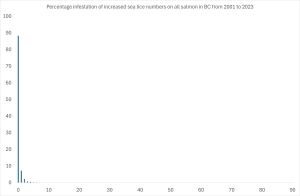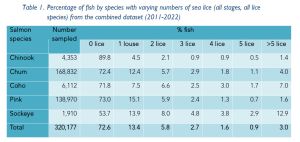Canada 1: Early last year, the BC Salmon Farmers Association published a comprehensive report ‘Modern Salmon Farming in BC: A Review’, with the intention of shedding light on all aspects of the world of salmon farming in Canada’s British Columbia.
Whilst the report covers every facet of salmon farming, I was disappointed that discussion of what I consider to be the most contentious issue was buried in chapter 10 and that is sea lice and interactions with wild salmon. This is the single issue that has driven most of the anti-salmon farm activity in BC and in my opinion is the one that should have been given the greatest prominence. This is because analysis of the sea lice infestation on wild salmon showed that 72.6% of the fish were free of lice. If the wild salmon are not infested with sea lice, they simply cannot be at risk of damage or death.
The data was also broken down into lice infestation on the five different species of wild salmon and the infestation with the two different species of sea lice. The infestation levels range from 71.8% lice free fish for coho salmon to 95.2% lice freer for sockeye. There are several reasons why this variation exists, including sample size, total sample number and the period over which the samples were taken. I have always been keen to examine the data myself, but my understanding is that BC Salmon Farmers Association had arranged with a research group to undertake the analysis and when they were done it would be placed into the public domain.
Last week, the whole dataset from 2001 to 2023 was published in the scientific data section of the Nature website. However, unlike other datasets that I have previously downloaded, authors publish a Data Descriptor along with the data. To all intents and purposes, the Data Descriptor is just like a published paper, with an Abstract, Background and Summary, Methods, Data Records, Technical Validation, Usage Notes and References, which in this case number 27 in total. What of course is missing is any analysis or discussion of the data, presumably because the data is linked to a published paper. The website Scientific Data states that amongst the aims of these papers is to help describe how to source and to use the data to facilitate scientific advancement. However, after reading this paper, I can only conclude that its description promotes exactly the opposite by highlighting long-term entrenched views rather than allowing the data to speak for itself. I only wonder if the lead researcher has actually analysed the data at all.
The abstract begins – ‘Monitoring sea lice infestation on populations of farmed and wild salmon is critical to the development of evidence-based policy designed to mitigate the risk these ectoparasites represent to wild juvenile salmon’.
The background section continues that ‘In locations where significant stocks of wild salmonids are present, a clear understanding of sea lice infestation patterns in both wild and farmed salmon populations is of paramount importance due to potential spillover effects which has been identified as a conservation issue in a number of countries’.
The paper then states that these challenges have been identified over the past two decades in BC and a wide range of studies have explored the patterns of infestation, the potential linkages between farmed and wild populations and the likely effects of these interactions. These are accompanied by links to 13 of the references. Almost all of which are the work of Dr Martin Krkosek or colleagues or associates of his. Regular readers of reLAKSation will know that Dr Krkosek is a close colleague of anti-salmon farm activist Alexandra Morton. In the past, I have written to Dr Krkosek with the aim of discussing some of the issues, but he has never responded.
I would suggest that whilst the message from this paper is that sea lice have a deleterious effect on wild salmon, at least from the background preamble, the accompanying data does not support this view at all. It will be interesting to see what any subsequent paper will claim.
So, what does this data show?
In total the dataset runs to 376,764 fish although 14,700 of the fish are not salmon. These include Pacific herring, Three spined stickleback and ‘other’ species. This leaves a dataset of 362,055 salmon, of which pinks and chum are the most numerous. The other three salmon species combined total about 23,300 fish.
Unlike the results reported in the BC Salmon Farmers Association review, I opted to analyse the data based on the specific species of sea lice. The first analysis relates to the salmon louse, Lepeophtheirus salmonis, and covers infestation of all five salmon species. The graph of percentage infestation for increasing lice numbers is shown below.

This graph is a classic aggregated distribution which is what would be expected of a parasite. However, I now fully understand why the BC Salmon Farmers Association opted to use a pie chart rather than the format above. After lice levels of five to six, the numbers are so small they do not register on the graph at all.
The numbers are that 88.3% have no lice, 7.2% carry just one louse, 2.2% carry two lice, 0.7% have three and 0.5% have four. The remaining infestations which reach 380 on one fish amount to 1.05% of all the salmon sampled.
The key question is that if 88% of juvenile wild salmon are free of lice, how can sea lice represent a risk to wild fish stocks? Unfortunately, those promoting the idea that they do represent a risk never respond when this question is posed.
When the data of the second louse – Caligus clemensi is analysed, the percentage of fish that carry no lice is 91.7% The rest of the numbers are shown on the following chart which also shows the infestation levels for both species of sea lice on all five species of Pacific salmon.

I have used the same format as BC Salmon Farmers Association to summarise these infestations although their table as follows is for infestation by all sea lice and for a shorter time period.

The low percentage for lice free sockeye appears to be due to a higher level of infestation by Caligus rather than the Lep sea lice. There could be several reasons for this but any suggestion on my behalf would be conjecture rather than hard evidence.
What is interesting is that the data also includes lice counts on 10,427 three spined sticklebacks as shown in the following table:

It has been previously suggested that the three spined stickleback is a temporary host for Lep sea lice, but this idea seems subject to limited investigation. It is interesting that the pattern of lice infestation mirrors that of salmon, which is what would be expected. The data is so extensive that it will require a great deal more analysis to ascertain exactly where the sticklebacks were caught and the level of infestation. However, this is a side issue compared to the fact that the percentage of sea lice free salmon is so high over many years, and thus sea lice are clearly not the reason why wild salmon may be judged to be in decline in areas of salmon farm operation.
This paper raises one other area of concern. The lead authors write that one of the key objectives by creating this dataset was to find a data format that allows for maximal temporal and spatial comparisons. In the case of measurement of lice infestation on salmon farms, the authors use a mean monthly abundance based on the total sea lice counts divided by the number of sampled fish. The mean monthly abundance is displayed in a table in their paper which for example for DFO Health sub zone 2.4 for the years from 2004 to 2023 range from 0.26 to 3.18 with a median value of 0.6. For all seven zones, values range from 0.02 to 7.73 with an average median value of 0.69.
My own view is that these values are misleading and do not reflect the true infestation levels of salmon held in farms.
If I use the example of total infestation of all wild salmon by both species of sea lice, then just over 90% of the fish are lice free. If the combined lice abundance is calculated, then this works out as 0.44. This is not greatly different to the media abundance calculated from 140 different entries from seven zones over twenty years. This would suggest that many of the fish held in farms over this period are actually free of lice, which is what would be expected from the distribution aspect of parasite ecology.
What this extensive dataset confirms is that we as an industry need to wipe the slate clean and start again from first principles. We currently have a narrative based on the blinkered views of anglers and activists instead of one based on facts and evidence.
Canada 2: The dataset discussed above was published on July 31st. Just the day before a group of eleven ’organisations’ sent a letter to the Minister of Fisheries Oceans and the Canadian Coast Guard, the Honourable Joanne Thompson demanding that the Candain Government follow through on its commitment to remove salmon farms from BC waters by 2029. The letter was headed by Stan Proboszcz of Watershed Watch Salmon Society.
The basis of their demands is the publication of a paper in June by Jaewoon Jeong and five colleagues from DFO, which the letter says contradicts an earlier DFO report from 2023 which suggested that there is no significant association between sea lice on wild salmon and sea lice from nearby salmon farms.
The letter continues that the 2025 paper uses the same core dataset as the 2023 report applied two more years of data and applied more advanced statistical modelling. They conclude that the 2023 DFO report has not stood up to rigorous scientific scrutiny.
The abstract of the new paper says that it was a mixed effects regression model that has revealed a significant positive relationship between farmed and wild salmon at the sampling event level with notable variations in location and time. The abstract goes on to say that ‘the complexities and uncertainties in quantifying infestation pressure underscore the need for further research. Clearly, the findings are not cut and dried as the author’s need for further research suggests that the relationship between farmed and wild salmon is still not ready for rigorous scientific scrutiny.
Certainly, the reference to sampling events leads to uncertainty as the number of fish caught ranged between 1 and 60 but fish other than pinks and chum salmon were excluded as were samples of 10 fish or less because they were considered unrepresentative. Yet, the average number of fish per sample was only 15 fish which brings into question whether even 15 are representative either. Certainly, it is only when many samples are combined that the true picture of infestation emerges as discussed in the earlier commentary.
From my perspective there is too much weight given to peer reviewed papers because whilst the headlines may suit any particular narrative, the detail often is much less persuasive.
I have written to Stan Proboszcz to raise a number of points. However, I suspect that I won’t receive a reply. After all, some of the others signing the letter have a long history of evading answering any questions. These include Alexandra Morton of Pacific Coast Wild Salmon Society, and groups like Clayoquot Action, David Suzuki Foundation and Living Oceans Society. Why should now be any different?

